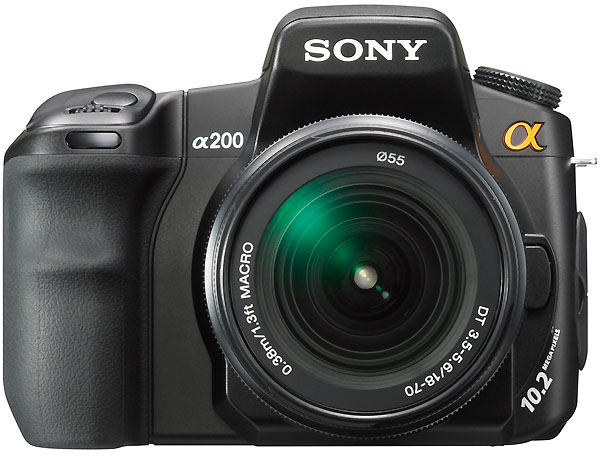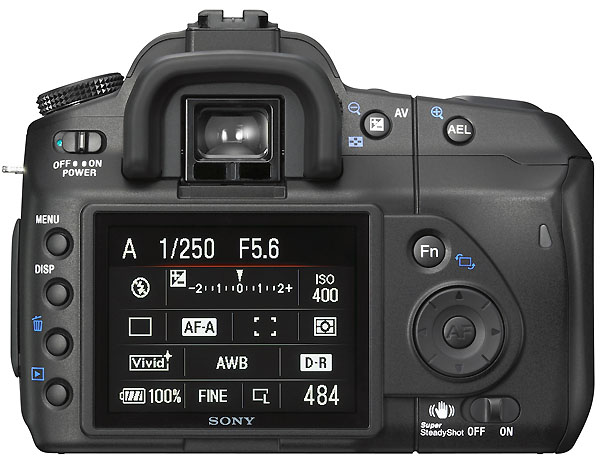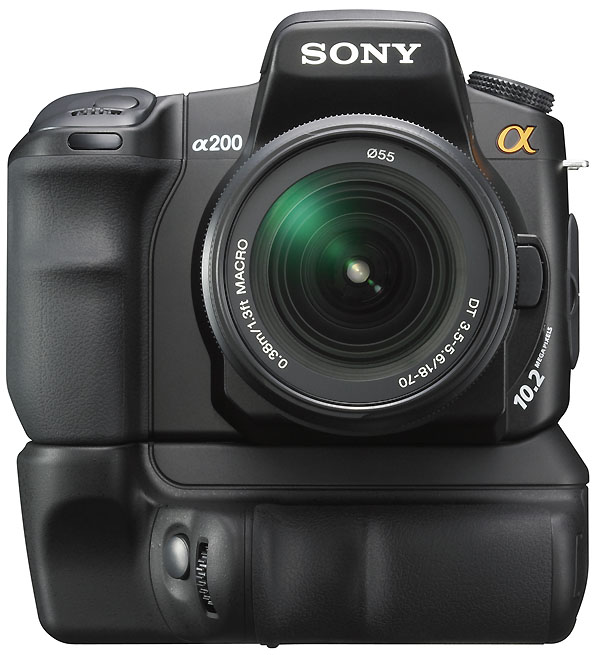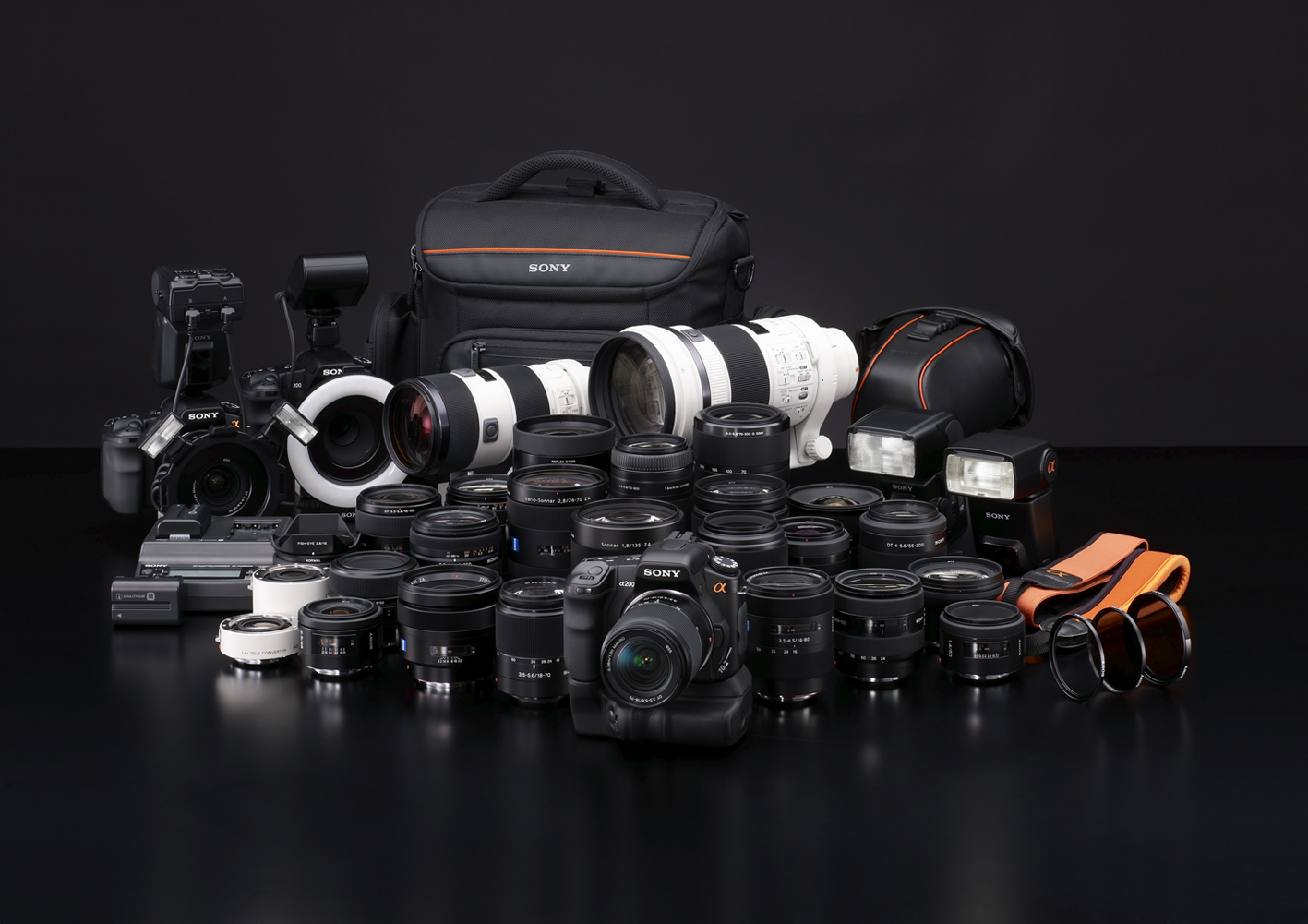The Sony Alpha 200 launched
AT THE Consumer Electronics Show, Las Vegas, Sony has announced introduction of the new Alpha DSLR-A200 camera which has been the subject of some strange speculation but was known beforehand to be a replacement for the Alpha 100. This is the first time a DSLR has been launched to the world at this show, and Sony’s decision to do so sends a major signal out as to where they see themselves and the Alpha system in the marketplace. It is highly competitive in price and we have just ordered our body for £369 including VAT (£314 + VAT) plus £13 express shipping from www.sonystyle.co.uk. This is exactly the same price as we paid for our last Alpha 100 in summer 2006.

The Alpha 200 takes parts of the Alpha 100 (specifically, the shutter and single control wheel assembly, and the main rear controls of multi-way joypad and buttons) and blends them into a body borrowing aspects of Alpha 700 design including the Quick Navi screen-based function interface and single left hand main mode dial. The function selector dial disappears entirely, replaced by a new rear Fn button and a larger 2.7 inch screen which offers high visibility in bright daylight.
It should be possible to view photographs in full sunlight, and see settings (now essential) in the same conditions. The screen may prove superior to the Alpha 700 in this respect. Also, the review mode offers either Luminance or RGB histogram display with separate channel graphs.

Inside the camera, the shutter mechanism remains unchanged in specifications (30 seconds to 1/4,000th with X at 1/160th) but a claim is made for quieter operation. This probably related more to the mirror, though Sony say a quieter shutter sound; it isn’t really the shutter which offends the ear in the Alpha 100, but the mirror action. The mirror mechanism is probably now shared with the Alpha 700 or based on the 700 action.
The high torque AF drive motor, introduced in the Alpha 700, was judged by users to be ‘twice as fast’ subjectively as the Alpha 100. Now we have a figure, because the Alpha 200 has been given a similar motor and the actual speed is 1.7X as fast. This is combined with faster startup time, less mirror-action lag, and improved predictive focus algorithms. It is the first time that Sony has made reference to ‘predictive’ functions which Minolta pioneered.
The AF module is nine points with centre cross sensor, and the metering is 40 segments; these are both familiar from the Alpha 100, but we are promised better AF performance and presumably better calibration (though they would never suggest that earlier models were not well calibrated!).
The viewfinder is unchanged in specification, and is presumably the same roof mirror porroprism as the Alpha 100, and will have the same limitations of brightness and accuracy. There is no grip start, just Eye Start, and there is no AF illuminator or provision for remote wireless control. The socket for wired remote is moved the end of the camera in a power/interface arrangement similar to the A700 but using a single soft plastic opening flap (there is only one on the camera in total – Sony manufacturing economy!). The SSS switch is turned sideways and placed where the cable release ‘Remote’ socket was. Some space has been saved on the body, but the grip remains as large as the Alpha 100 and the gap between grip and lens (for fingers) is not reduced.
Having a single control wheel, the Alpha 200 uses the +/- over-ride button to double up as a switch mode between altering shutter and aperture when working in Manual (AV, aperture variation, is marked next to it to indicate that this function can apply).
This new group shot includes the Carl Zeiss 24-70mm f/2.8, which we are dismayed to see is physically larger than the 135mm f/1.8 – surely not an absolute design necessity, when 24-70mm is an ideal everyday range, to make it inconveniently huge!
As for imaging, we have exactly the same CCD pixel count as the Alpha 100, and a stabilisation carriage which still offers the same maximum 3.5 steps of SSS, rather than the 700’s improvement t0 4 steps. However, the range is 2.5-3.5 not 2-3.5 which applied to the A100 so something has been tweaked. More important is that something has also been done with the 10 megapixel image. The processor and the focusing screen are now equipped for switching to a 16:9 shooting mode if you wish. This information is only provided on one Sony web page – http://www.sony.co.uk/view/ShowHubPage.action?site=odw_en_GB&hubpage=1198162912984 This makes it sound live Bravia HDTV viewing, but the manual for the camera can already be downloaded from the USA – thanks to Andy Johnson of UKExpert for the link – http://esupport.sony.com/US/perl/model-documents.pl?mdl=DSLRA200K There may be a 16:9 shooting mode but there is no dedicated 16:9 connection, just regular USB/Video out like the Alpha 100.
High ISO noise reduction is now only applied at 1600 or 3200, a new high setting which does not exist on the A100, and it can be turned off entirely. It is applied between the raw image save (whether retained and written to file as .ARW) and the JPEG – it is part of the JPEG production process. This implies that either there is no NR present on raw files at all, or there is a fixed NR which Sony has not chosen to detail at this stage though it is implied in descriptions of changes to the sensor and processor setup. There is no mention of pre-RAW noise reduction or on-sensor noise control similar to the CMOS based A700. The A200 sensor is a CCD and can’t use the same techniques.
However, the raw file format is said to be .ARW2, the same as the Alpha 700, despite the different image dimensions, and to be readable for 700-compatible raw processing software. All we can say is that the proof will have to wait for camera samples and testing. The noises made are promising… let’s hope the noise is promising as well. Advance samples indicate that it will be: http://www.sony.net/Products/dslr/a200/features.html
Consider these statements from Sony: From the USA: “With its 10.2-megapixel (effective) APS CCD image sensor, the DSLR-A200 camera continues to offer high-quality images by allowing more light to pass through to each pixel – increasing sensitivity, reducing noise, and providing greater detail. Clean, reduced-noise signals are sent from the image sensor to Sony’s BIONZâ„¢ processing engine, which processes data-rich picture information at high speeds and reduces picture noise in the RAW data stage before image JPEG conversion. The results are high-resolution, detailed images with rich tonal reproduction.” ‘More light to pass through each pixel’ is a meaningful term. Have they changed the microlenses? Do they mean relative to 12 megapixels, or relative to the earlier 10 megapixel CCD? If they have improved the 10 megapixel CCD physically, by changing the microlens and filtration layers, then we could be seeing a doubling in sensitivity before any changes to processing.
The statement continues: “Clean, reduced-noise signals are sent from the image sensor to Sony’s BIONZ processing engine, which processes data-rich picture information at high speeds and reduces picture noise in the RAW data stage before image JPEG conversion. The results are high-resolution, detailed images with rich tonal reproduction.” Now here’s one from the UK: “The A200 features powerful noise reduction and image processing techniques from the advanced Sony A700 to deliver even higher picture quality – even under challenging shooting conditions. Delivering rich, vivid colours and brilliantly detailed tonal reproduction, 10.2 effective megapixel CCD sensor gains new noise reduction circuitry. Performance of the BIONZ image processing engine is also enhanced, contributing to lower picture noise in all shooting situations. Sensitivity is boosted to a maximum ISO 3200, allowing successful handheld shooting in low-light conditions without flash. A special High ISO Noise Reduction mode improves picture quality still further at increased sensitivity settings.”
This one definitely indicates that A700-style pre-RAW NR may be used and that some kind of on-sensor, or early analog stage, NR may be used. The signal chain is cleaned up too, from the sound of this wording. It comes from the UK press agents for Sony, and I have not seen any similar direct claims made by Sony websites, but it hardly sounds made up. It sounds as if the PR agency has sat through a presentation given by Sony UK in which this greater level of information was present.
The D-Range Optimizer is said to incorporate Off, Standard and Advanced modes rather than Off, Standard, Advanced Auto and Advanced Manual modes as in the Alpha 700 or Off, Standard and Advanced modes as in the A100. The European release confirms that ‘Advanced’ in the A200 is an auto option, not a manually set range as in the A700, but it is supposed to be enhanced relative to the A100 process. The shooting speed and buffer size are unchanged at 3 fps and 6 raw frames, but we know that the Alpha 100 will manage many more raws in sequence when using very fast cards, and this will have to be tested. Sony is extremely conservative about the potential for continuous shoot sequences. 
Other key changes include use of the same InfoLithium lithium-ion battery as the Alpha 700, with a percentage readout of remaining power, and a vertical grip VG-B30AM (what’s the betting this fits an Alpha 300 too, with that name?) carrying duplicated controls and twin battery chamber as an optional accessory. The camera display is ready to handle twin battery percentage readout. The camera has a CompactFlash card slot only and no MemoryStick adaptor is provided free – that, too, is an optional add-on. The standard kit includes the 18-70mm lens, and a twin lens kit will include the 75-300mm as well. The prices look almost directly comparable to the Alpha 100 allowing for typical street value shifts.

There is no provision for studio flash X-sync socket, and the built-in flash has been substantially modified to include Auto Pop-Up option (very easily disabled, by setting the mode dial – no need even to dive into menus to prevent this happening). The logo fascia now extends up the top of the flash, with either a larger (wider) flash reflector area or a smaller one – which would not be a good point. It is very hard to tell from pictures, but the flash window is longer and narrower, less square. A new flash, the HVL-F42AM, is shown in the group shot in place of the HVL-F36AM (aka 3600 HS D). This probably means the 36 model, which has no provision for bounce orientation suitable for use with the vertical grip, has been replaced. The 42 seems more fully featured, with variable power, and a two-way bounce head which rotates in the reverse direction to the 56 (making it more versatile for vertical compositions with the grip).
The lens mount is also the new larger, tighter variant seen on the Alpha 700 with more metal exposed all round. It will probably be incompatible with many Alpha-to-M42 adaptors, just as the Alpha 700 is, because of this change. It has the new big lens release button, a major improvement on the original Minolta design (even the Alpha 100 was pretty good, and it just gets better with the 200). The Depth of Field Preview appears to be omitted entirely from the 200. There is no provision for using the wireless remote control RMT-DSLR1 from the 700.
For existing Alpha system users, everything will depend on what Sony has done to the image processing to get a usable 3200. If they have matched the Nikon D80, or even the Pentax K10D, this new model may even be preferable to the Alpha 700 for some applications. If they have gone for aggressive colour blurring or performed early stages of noise reduction which can not be controlled, they may have a very nice point and shoot to compete with Fuji pocket cameras. The official launch has now taken place and all Sony sites should be displaying information.
You can download a PDF of A200 specs here, but here are what Sony see as the key points:
Alpha 200 Key Features
- Camera type: Digital SLR with built-in flash and interchangeable lenses
- Lens mount: Compatible with Sony a lenses and Konica Minolta/Minolta MAXXUM/ DYNAX lenses
- Image sensor: APS-C size CCD with anti-dust system
- Sensor resolution: 10.2 effective megapixels
- Image processor: Sony BIONZ engine
- Image stabilisation: Super SteadyShot with approx. 2.5“ 3.5 EV decrease in shutter speed (actual stabilisation depends on shooting conditions and lens)
- Noise reduction: Long exp. & High ISO NR at ISO1600 / 3200 (can be switched ON/OFF for both parameters!)
- Creative Styles Preset modes: Standard, Vivid, Portrait, Landscape, Night View, Sunset, B/W, Adobe RGB.
- Adjustable parameters: Contrast, Saturation, Sharpness
- D-Range Optimiser operating modes: Off, Standard, Advanced
- Scene Selection modes: Portrait, Landscape, Macro, Sports, Sunset, Night Portrait/Night View
- Viewfinder Field of view: 95% / Magnification: 0.83x
- AF system: TTL phase detection, centre-cross 9-point
- Sensitivity: ISO100 – 3200 equivalent (Recommended Exposure Index)
- Light metering: 40-segment honeycomb with multi-segment, spot and centre weighted modes
- Flash modes: Auto, Fill-in, Wireless, Rear, High Speed Synchro and Slow Synchro (Wireless and High Speed Synchro modes require optional accessory flash HVL-F56AM or HVL-F36AM)
- Built-in flash system: Auto popup (GN 12) with manual popup button
- Shutter speed range: 1/4000 sec. – 30 sec., bulb (Flash sync speed 1/160 sec.)
- Continuous shooting rate: Up to approx. 3 fps Max no. of frames JPEG Fine/Std: unlimited (until memory card is full), RAW+JPEG: 3, RAW: 6 recordable (continuous)
- Monitor screen: Transparent TFT/2.7-inch Clear Photo LCD (230k dots) with AR coating
- Histogram display: Brightness, RGB
- Function menu: Camera Function Display with direct control of Flash Mode, AF Mode, WB, Metering Mode, AF Area, DRO
- Battery type: NP-FM500H with InfoLITHIUM % power remaining display on screen
- Battery life: Approx. 750 shots (CIPA measurement)
- Vertical control grip: VG-B30AM (optional) accepts up to 2x NP-FM500H batteries
- Recording media: CompactFlash card: Type I, Type II (Microdrive)
- Memory Stick Duo: Memory Stick PRO Duo, Memory Stick PRO-HG Duo with optional adaptor
- Dimensions (WxHxD): Approx. 130.8 x 98.5 x 71.3 mm (excl. protrusions)
- Weight: Approx. 532 g (w/o batteries or memory card)
– David Kilpatrick


This is looking good. I thought Sony had to deal with the high noise problems in an otherwise great camera. Had been looking at the A700 but price is a put off, and probably wouldnt make full use of it.
Looking forward to Davids review,one I will believe.
High ISO performance looks good to me and not much worse than the KMs! I rarely venture higher than ISO800 but the performance of the A100 was euphemistically said not so good. Good to see that Sony heed to the issues people raised on the A100.
The best set of A200 samples I have seen yet. Portraits with crops from ISO 100-3200 with exif.
http://masterchong.com/v2/dslr-guide/sony-alpha-200-a200-iso-100-iso-3200-sample-photos.html
Not looking so bad at first glance.
-Sonolta
http://www.sonolta.com
A200 ISO crop series are coming out fast and furious!
http://www.cameralabs.com/reviews/Sony_Alpha_DSLR_A200/
-Sonolta
http://www.sonolta.com
It looks as if we have an early peek at some A200 ISO series crops:
http://fabu.beareyes.com.cn/2/lib/200801/07/20080107232.htm
-Sonolta
http://www.sonolta.com
It is interesting that at the photo with lenses we see 24-70/2.8 ZA first time officially 😉
Very nice! Looks like a decent replacement for the Sony A100. Some user concerns on the A100 seem to have been be addressed.
Price point does not sound do bad either possibly leaving a spot for a EVIL cam somewhere above it? Well, maybe.
Happy shooting!
-Sonolta
http://www.sonolta.com
PS…I have posted another 30 new A700 ISO 100 and 1250 snaps to the Christmas gallery.